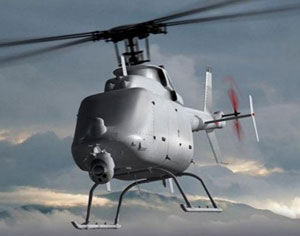
The Navy’s newest variant of the Fire Scout unmanned helicopter completed its first day of flying today, Oct. 31 at Naval Base Ventura County at Point Mugu, CA. The unmanned helicopter lifted off at 12:05 pm PDT and flew for seven minutes in restricted airspace to validate the autonomous control systems. The second flight that took off at 2:39 pm was also flown in a pattern around the airfield, reaching 500 feet altitude. The Northrop Grumman MQ-8C is a larger air vehicle will can provide, has a range of 150 nautical miles and a payload capacity of more than 700 pounds. The MQ-8C air vehicle upgrade will provide longer endurance, range and greater payload capability than the MQ-8B, which is currently operating aboard USS Samuel B. Roberts.
According to Capt. Patrick Smith, Fire Scout program manager at Patuxent River, Md., the MQ-8Cs will conduct initial shipboard testing on Guided Missile Destroyers (DDG)-class ships but the program is looking into supporting Littoral Combat Ship (LCS) missions. The Navy will continue to use the MQ-8B as we phase in the MQ-8C. Lessons learned from MQ-8B have been applied to MQ-8C variant, Smith said. Initial operating capability for the MQ-8C is planned for 2016, with a potential for early deployment in 2014.
“It is a big accomplishment for the integrated government and industry team to fly this air vehicle for the first time”, said Smith “MQ-8C, will require fewer aircraft [than the MQ-8B], to operate at maximum performance and will meet the U.S. Africa and Special Operation Commands urgent needs requirement.”
“With the MQ-8C, we took a commercial Bell 407 helicopter and modified it to include additional fuel capability, upgraded engines and improved reliability to provide increased range and endurance and then integrated the majority of the MQ-8B avionics and payloads onto that air frame. This method allows us to maintain the entire infrastructure we have already invested in.” Smith added.





















